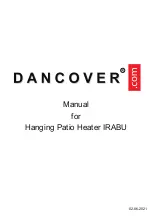
26
GENERAL INFORMATION
POWER BURNER
The SEQUENCE OF OPERATION is provided on page 21 and the
INITIAL START-UP procedure of the unit on page 23.
HIGH LIMIT
The high limit switch (not adjustable) is factory set to cutout at
199°F (93°C). The controller must be manually reset by cycling the
power to the unit and the water temperature must be below
180°F (82°C).
TABLE 4
GAS SUPPLY SPECIFICATIONS
RTF-120 Natural Gas
Max. Gas Supply Pressure W.C.
14.0 (3 kPa)
Nominal Gas Supply Press. W.C
7.0 (1.74 kPa)
Minimal Gas Supply Press. W.C.
6.2 (1.53 kPa)
Manifold Press. W.C.
4.5 (1 kPa)
HIGH ALTITUDE INSTALLATIONS
WARNING
THE SRT80-120E IS CERTIFIED FOR USE WITHOUT MODIFICATION
FOR ALTITUDES UP TO 2000 FEET. INSTALLATIONS ABOVE 2000
FEET MAY REQUIRE REPLACEMENT OF THE BURNER ORIFICE IN
ACCORDANCE WITH THE NATIONAL FUEL GAS CODE (ANSI Z223.1/
NFPA 54). FAILURE TO REPLACE THE ORIFICE WILL RESULT IN
IMPROPER AND INEFFICIENT OPERATION OF THE APPLIANCE,
PRODUCING CABON MONOXIDE GAS IN EXCESS OF SAFE LIMITS,
WHICH COULD RESULT IN SERIOUS PERSONAL INJURY OR DEATH.
Some gas utility companies derate their gas for altitude, making it
unnecessary to install high altitude orifices. Call the local gas or
utility company to verify BTU content.
Due to the input rating reduction at high altitudes, the output rating
of the appliance is also reduced and should be compensated for
in the sizing of the equipment for applications.
MAINTENANCE
GENERAL
KEEP APPLIANCE AREA CLEAR AND FREE FROM COMBUSTIBLE
MATERIALS, GASOLINE AND OTHER FLAMMABLE VAPORS AND
LIQUIDS. (SEE WARNING ON PAGE 11, LOCATING THE HEATER).
Water heater maintenance includes periodic tank flushing and
cleaning, and removal of lime scale. The unit should be inspected
and adjusted to maintain proper combustion. Refer to the following
table. A periodic inspection of the venting system should be made.
Where used, the water circulating pump should be oiled.
(1) If furnished with oiling provision.
COMPONENT
OPERATION
INTERVAL
REQUIRED
Tank
Sediment Removal
Monthly
Flushing
Tank
Lime Scale Removal
Semi-Annually UN-LIME
®
Delimer
Anode Rods
Inspect
Semi-Annually
Replace as
Required
Relief Valve
Inspect
Semi-Annually
Circulating
SAE No. 20
Pump (1)
Oiling
Four Months
non-detergent
motor oil
Blower
Clean Inlet Screen
and Blower Wheel
As Required
Soft Brush
Vent System
Inspect
Every 3 Months
Joints should
be sealed
MAINTENANCE SCHEDULE
Following are the instructions for performing some of the
recommended maintenance. Unit inspection and adjustment
should be performed by a competent technician.
FLUSHING
1. Turn off the heater electrical disconnect switch.
2. Open the drain valve and allow water to flow until it runs clean.
3. Close the drain valve when finished flushing.
4. Turn on the heater electrical disconnect switch.
DRAINING
Maintenance and service procedures may also require draining
the heater.
1. Turn off the heater electrical disconnect switch.
2. Close the cold water inlet valve to heater.
3. Open a nearby hot water faucet to vent the system.
4. Open the gate valve on plumbing manifold.
5. If the heater is being drained for an extended shutdown, it is
suggested the drain valve be left open during this period.
• Follow FILLING instructions when restoring hot water service.
SEDIMENT REMOVAL
Waterborne impurities consist of the particles of soil and sand
which settle out and form a layer of sediment on the bottom of the
tank.
For convenience, sediment removal and lime scale removal
should be performed at the same time.
LIME SCALE REMOVAL
The amount of calcium carbonate (lime) released from water is
in direct proportion to water temperature and usage. The higher
the water temperature or water usage, the more lime deposits
are dropped out of the water. This is the lime scale which forms in
pipes, heaters and on cooking utensils.
Lime accumulation not only reduces the life of the equipment but
also reduces efficiency of the heater and increases fuel
consumption.
The usage of water softening equipment greatly reduces the
hardness of the water. However, this equipment does not
always remove all of the hardness (lime). For this reason it is
recommended that a regular schedule for deliming be
maintained.
The depth of lime buildup should be measured periodically.
Heaters will have about 3" (7.6cm) of lime buildup when the level
of lime has reached the bottom of the cleanout opening or about
1" (2.5cm) of lime buildup if it has reached the drain valve opening.
A schedule for deliming should be set up, based on the amount
of time it would take for a 1" (2.5cm) buildup of lime.
Example 1:
Initial six-month inspection shows 1/2" (1.3cm) of lime
accumulation. Therefore, the heater can be delimed once
a year.
Example 2 :
Initial six-month inspection shows 2" (5cm) of lime
accumulation. Therefore, the heater should be delimed every
3 months.
Содержание ROOFTOP SRT80 120NE
Страница 18: ...18 FIGURE 36 ...











































